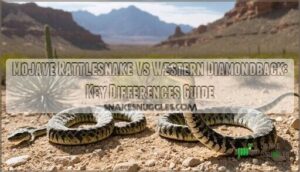This site is supported by our readers. We may earn a commission, at no cost to you, if you purchase through links.

The Mojave’s venom contains both neurotoxins and hemotoxins, making it roughly ten times more potent than the western diamondback’s primarily tissue-destroying venom.
You can tell them apart by color patterns—Mojaves display muted greenish-gray tones with faint banding, while western diamondbacks show bold diamond shapes with stark black-and-white tail rings.
Both species share overlapping territories across southwestern deserts, but Mojaves prefer rocky, higher-elevation areas.
Understanding these key differences becomes essential when you’re exploring their shared habitat.
Table Of Contents
- Key Takeaways
- Differences Between Mojave Rattlesnake and Western Diamondback
- Similarities Between Mojave Rattlesnake and Western Diamondback
- Identifying The Mojave Rattlesnake
- Identifying The Western Diamondback
- Mohave Greens and Other Confusions
- Understanding The Venom of Mohave Rattlesnake
- Behavioral Traits of Mohave Rattlesnake
- Frequently Asked Questions (FAQs)
- What is the difference between a mojave and a diamondback rattlesnake?
- How long do Mojave and diamondback rattlesnakes live?
- What predators hunt these two rattlesnake species?
- How do mating seasons differ between species?
- Can these rattlesnakes interbreed or hybridize?
- What first aid should you apply immediately?
- Conclusion
Key Takeaways
- You’ll face 10 times deadlier venom with Mojaves – their neurotoxic bite causes paralysis and respiratory failure, while western diamondbacks deliver tissue-damaging hemotoxins that rarely prove fatal in healthy adults.
- You can identify them by tail bands and coloration – Mojaves show wider white bands with muted greenish-gray tones, while western diamondbacks display equal-width black and white bands with bold diamond patterns.
- You’ll find them in different preferred habitats – Mojaves stick to rocky, higher-elevation desert areas, while western diamondbacks adapt to diverse environments, including grasslands and suburban areas.
- You need immediate medical attention for both species – though Mojave bites require respiratory monitoring due to their neurotoxic effects, while diamondback bites cause immediate severe pain and swelling.
Differences Between Mojave Rattlesnake and Western Diamondback
When you encounter rattlesnakes in the southwestern United States, distinguishing between Mojave and Western Diamondback species becomes essential for understanding the potential danger level.
These two venomous snakes share overlapping territories but differ substantially in their venom potency, physical appearance, and preferred habitats.
Venom
The venom potency difference between these two species can be a matter of life and death.
One wrong identification could mean the difference between surviving and dying from envenomation.
Mojave venom contains a lethal neurotoxin called Mojave toxin, making it roughly 10 times more potent than diamondback venom.
While Western Diamondbacks deliver more venom per bite (200-300mg vs 45-70mg), the Mojave’s neurotoxic effects cause paralysis and respiratory failure with minimal initial pain.
Diamondback venom is primarily hemotoxic, causing immediate severe pain and tissue damage but rarely proving fatal in healthy adults.
- Venom Composition: Mojave contains deadly neurotoxins; Diamondback relies on tissue-destroying hemotoxins
- Bite Symptoms: Mojave causes delayed paralysis; Diamondback triggers instant swelling and pain
- Toxicity Levels: Mojave LD50 ranges 0.23-1.5 mg/kg; Diamondback falls between 2.2-4.5 mg/kg
- Medical Response: Both require immediate antivenom, but Mojave bites need respiratory monitoring
- Fatal Risk: Mojave bites progress rapidly from mild to life-threatening without swift treatment
Understanding the venom toxicity levels is essential for effective medical response and treatment.
Color
When you’re comparing these two venomous snakes, color differences provide key identification clues. The Mojave rattlesnake displays a base color ranging from olive green to almost brown, creating a more orderly appearance.
In contrast, the Western Diamondback shows greater color variability, with its base color spanning yellowish-gray to pink tones, often appearing more randomly speckled.
Both species feature diamond-shaped markings along their backs, but pattern differences become apparent with close observation. The Mojave’s coloration remains cleaner and more stable, while the Western Diamondback tends toward a more chaotic, mottled appearance.
Scale color also differs between species, contributing to their distinct visual signatures. Tail bands offer another reliable identifier. The Mojave typically shows wider white bands compared to black ones, while the Western Diamondback maintains more equal-width banding.
These diamond markings and coloration patterns reflect each snake’s environmental adaptations, helping them blend seamlessly into their respective desert and grassland homes. Understanding rattlesnake color patterns is essential for accurate species identification.
Habitat
Habitat-preferences reveal stark differences between these desert dwellers. The Mojave rattlesnake shows strong loyalty to arid desert regions, particularly the Mojave Desert and surrounding southwestern territories.
You’ll find them in sandy flats, sparse grasslands, and cactus-dominated landscapes from sea level to 5,000 feet elevation.
The Western diamondback demonstrates remarkable habitat flexibility, adapting to diverse ecosystem types across its broader geographic range. While they share desert habitats with Mojaves, diamondbacks thrive in grasslands, chaparral, forests, rocky hillsides, and even suburban areas up to 7,000 feet elevation.
Environmental factors shape their distribution patterns:
- Mojave territory: Open desert basins with scattered creosote bush and Joshua trees
- Diamondback domains: Mesquite thickets, riverbanks, and rocky outcrops with varied vegetation
- Shared spaces: Desert regions in Arizona and New Mexico where ranges overlap.
Understanding the rattlesnake habitat is essential for identifying their territories.
This ecosystem adaptation difference explains why you’re more likely to encounter diamondbacks near human developments, while Mojaves stick to remote desert regions.
Similarities Between Mojave Rattlesnake and Western Diamondback
While Mojave rattlesnakes and western diamondbacks differ substantially in venom potency and coloration, they share several important characteristics that can make field identification challenging.
You’ll notice both species exhibit similar diamond-shaped back patterns, possess the characteristic tail rattle, and follow comparable hunting strategies that target small mammals and birds.
Diet
Both species share remarkably similar feeding habits, making diet an unreliable distinguishing feature.
You’ll find these rattlesnakes targeting the same prey populations across their overlapping ranges.
Their hunting tactics involve ambush strategies, where they coil motionlessly and strike when small animals pass within range.
| Dietary Aspect | Mojave & Western Diamondback |
|---|---|
| Primary Food Sources | Rodents, rabbits, ground squirrels |
| Secondary Prey | Lizards, birds, small mammals |
| Feeding Habits | Ambush predators, infrequent meals |
Both species exhibit identical nutritional needs, consuming prey whole after envenomation.
They’ll wait patiently for hours near rodent burrows or game trails.
Prey selection depends on availability rather than species preference.
Young snakes focus more on lizards and smaller rodents, while adults tackle larger mammals.
Their similar diet reflects shared evolutionary adaptations to arid environments where these food sources remain most abundant year-round.
Markings
Both species share remarkably similar diamond patterns that can confuse even experienced observers.
You’ll notice these serpents display comparable geometric markings across their backs, creating identification challenges in overlapping territories.
Key shared marking characteristics include:
- Diamond patterns: Both display distinctive diamond-shaped markings running along their dorsal surfaces
- Tail bands: Each species exhibits alternating light and dark banding near the tail tip
- Scale differences: Similar head scaling arrangements, though proportions vary between species
- Color variations: Both show brown-to-gray base coloration with darker accents
- Facial stripes: Light-colored eye stripes appear on both Mojave Rattlesnake and Western Diamondback specimens
These shared features evolved as effective camouflage strategies in desert environments.
However, subtle variations in band width, scale size, and pattern intensity help distinguish these potentially dangerous species when you know what to look for.
Tail Tip Rattler
Both species share an unmistakable warning system: the tail tip rattler. When you encounter either a Mojave Rattlesnake or Western Diamondback, you’ll hear their signature rattle sounds before seeing them.
This snake anatomy feature consists of hollow, interlocking segments that create buzzing vibrations when shaken rapidly. Both species display similar rattler behavior, using their tail length advantage to warn potential threats from a safe distance.
In desert survival situations, this shared characteristic makes rattlesnake identification challenging initially. However, understanding this common defensive mechanism helps with snake comparison studies and emphasizes why both species command equal respect in their overlapping habitats, due to their unique ability to warn using the rattle sounds.
Identifying The Mojave Rattlesnake
Now that you understand what these rattlesnakes share, let’s focus on pinpointing a Mojave rattlesnake in the field. You’ll want to check several key features that work together like pieces of a puzzle.
Start with the scale patterns between the eyes – Mojave rattlesnakes typically display 2-3 enlarged scales in this area, while their diamondback cousins have smaller, more numerous scales. The head shape appears slightly more triangular and defined.
Coloration provides another strong clue. Mojaves show a cleaner, more orderly appearance with olive-green to brownish base colors. Their diamond patterns look more precise and fade noticeably toward the tail, unlike the consistently bold markings you’d see elsewhere.
Tail bands offer perhaps the most reliable field mark – Mojaves display wider white bands compared to black ones, creating an uneven striping pattern. Eye stripes extend past the mouth without touching it, giving the face a distinctive look.
For positive rattlesnake identification of Crotalus scutulatus, combine these features rather than relying on just one characteristic. This snake identification guide approach prevents misidentification of the potentially dangerous Mojave green rattlesnake. Understanding the venom toxicity levels is essential for handling and safety precautions when dealing with Mojave rattlesnakes.
Identifying The Western Diamondback
You’ll recognize a western diamondback rattlesnake by focusing on several distinctive features that set Crotalus atrox apart from its desert cousin.
These venomous snakes display characteristic markings that make snake identification more straightforward once you know what to look for.
The western diamondback’s most notable feature is its prominent diamond pattern along the back, consisting of dark diamond-shaped blotches outlined in lighter scales. Unlike the Mojave’s fading pattern, these diamonds remain bold throughout the snake’s length. Body coloration ranges from yellowish-gray to pink, creating a more randomly speckled appearance than the orderly Mojave.
Key identification markers include:
- Scale identification: Multiple small scales between the eyes (versus Mojave’s 2-3 large ones)
- Facial stripes: White stripe from eye that stops before reaching the mouth
- Tail banding: Equal-width black and white bands in a 1:1 ratio
- Size: Larger overall, reaching 2-7 feet versus Mojave’s 2-4 feet
Pay attention to the gestalt—western diamondbacks appear more chaotically patterned overall compared to the clean, stable coloration of Mojave rattlesnake species. Understanding venomous snake species is essential for accurate identification and safety precautions when encountering these animals.
Mohave Greens and Other Confusions
When you’re out in the field, distinguishing between these two dangerous species becomes trickier than you’d expect. The greenish coloration that gives the Mohave green rattlesnake its nickname can easily fool you into thinking you’ve spotted a western diamondback, especially when lighting conditions aren’t ideal.
The key to accurate identification lies in examining multiple characteristics simultaneously. You can’t rely on color variations alone, since desert habitats produce similar camouflage adaptations in both species. Pay attention to scale patterns between the eyes and tail band proportions.
| Feature | Mojave Rattlesnake | Western Diamondback | Key Difference |
|---|---|---|---|
| Scale Patterns | 2-3 large scales between eyes | Multiple smaller scales | Size and number |
| Color Variations | Olive green to brown base | Yellowish-gray to pink | Distinct hue ranges |
| Tail Bands | Wider white bands, 2:1 ratio | Equal-width bands, 1:1 ratio | Band proportions |
Snake behavior also differs slightly, with mojave rattlesnakes typically showing more defensive posturing when threatened. Remember, accurate rattlesnake differences identification combines several physical markers rather than depending on single features. This approach ensures a more reliable distinction between the two species, especially in situations where a quick and accurate identification is crucial.
Understanding The Venom of Mohave Rattlesnake
Mojave rattlesnake venom composition sets it apart as one of North America’s deadliest serpents. You’re dealing with a potent neurotoxin that attacks your nervous system, causing muscle weakness, drooping eyelids, and breathing difficulties.
The venom potency measures incredibly high, with toxicity levels reaching 0.23 mg/kg in laboratory tests—that’s ten times more lethal than western diamondback venom. When you encounter snakebite symptoms from a mojave rattlesnake, neurological effects dominate the clinical picture.
Unlike the western diamondback’s hemotoxic effects that cause tissue damage, mojave venom targets your brain and spinal cord. Snake venom toxicity varies regionally, but mojave populations consistently produce neurotoxin effects that can paralyze you within thirty minutes.
A venomous bite from this species requires immediate medical attention because standard antivenoms may not address the unique snake venom composition effectively. Treatment often involves administering specific Rattlesnake Antivenom to counteract the venom’s effects.
Behavioral Traits of Mohave Rattlesnake
Contrary to popular belief, you’ll find that Mojave rattlesnakes aren’t the aggressive predators many imagine. These snakes actually display heightened defensive behavior compared to other North American species, but they’re primarily defensive rather than offensive.
When you encounter one, you’ll notice their distinctive defensive posture includes an elevated body and rapid tail vibrations exceeding 50 shakes per second.
Their hunting tactics revolve around patience and precision. Ambush strategies dominate their feeding approach, with heat sensing pits detecting warm-blooded prey from considerable distances. You’ll observe them waiting motionless near rodent trails, achieving a 63% strike success rate.
Unlike Western diamondback behavior, Mojave rattlesnakes show more calculated movements during hunts.
Territorial behavior emerges during spring mating season, when males patrol and defend specific areas. Their snake behavior patterns shift seasonally – they’re primarily nocturnal during hot months but become diurnal in cooler periods.
This rattlesnake comparison reveals Mojaves as more methodical hunters than their diamondback relatives, relying on stealth over snake aggression for survival success.
Frequently Asked Questions (FAQs)
What is the difference between a mojave and a diamondback rattlesnake?
You’ll spot key differences in tail banding, coloration, and venom potency.
Mojaves have wider white tail bands and greenish coloring, while diamondbacks show equal-width bands with darker, speckled patterns and more dangerous bites.
How long do Mojave and diamondback rattlesnakes live?
Like clockwork, both rattlesnake species typically live 15-25 years in the wild.
You’ll find Mojaves and diamondbacks have similar lifespans, though captive specimens can reach 30 years with proper care and veterinary attention.
What predators hunt these two rattlesnake species?
Birds of prey like hawks and eagles hunt both species, while ground predators including foxes, coyotes, and wild pigs target juveniles.
You’ll find king snakes particularly dangerous since they’re immune to rattlesnake venom and actively seek them out.
How do mating seasons differ between species?
Two desert dancers perform their courtship at different times.
Western diamondbacks usually mate during fall, while Mojave courtship begins in late summer/fall, is interrupted by winter, and resumes in spring.
Diamondbacks have simpler, fall-focused timing compared to Mojaves’ extended seasonal approach.
Can these rattlesnakes interbreed or hybridize?
These rattlesnake species can’t interbreed naturally. You won’t find hybrids in the wild because they’re genetically distinct species with different chromosome numbers and evolutionary histories, making successful reproduction impossible.
What first aid should you apply immediately?
Ironically, staying calm saves lives when panic seems natural.
Don’t tourniquet or cut the wound. Keep the bitten limb still and below heart level.
Remove jewelry quickly before swelling starts. Call 911 immediately and get to a hospital fast.
Conclusion
Recognizing the mojave rattlesnake vs western diamondback becomes essential for anyone venturing into desert territories.
You’ll want to remember that Mojaves deliver markedly more dangerous encounters due to their potent neurotoxic venom, while western diamondbacks rely on tissue-destroying compounds.
Their distinct color patterns, habitat preferences, and behavioral differences provide reliable identification markers.
When you encounter either species, maintain respectful distance and appreciate these remarkable desert survivors from afar.










